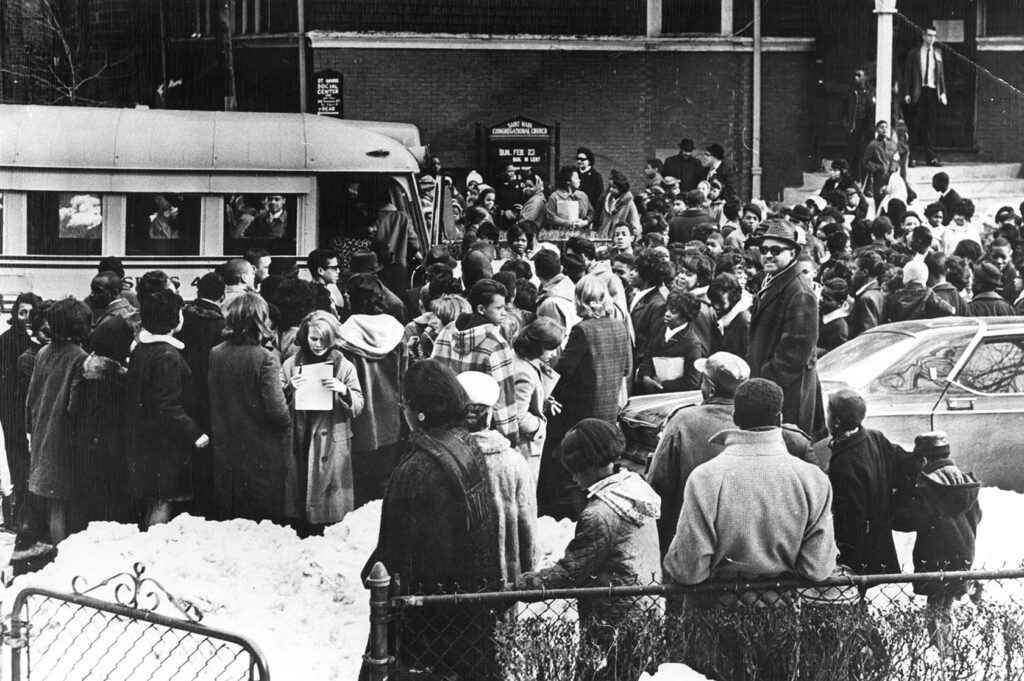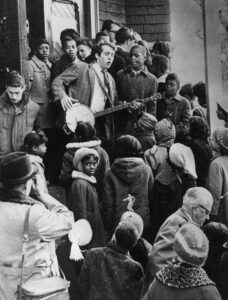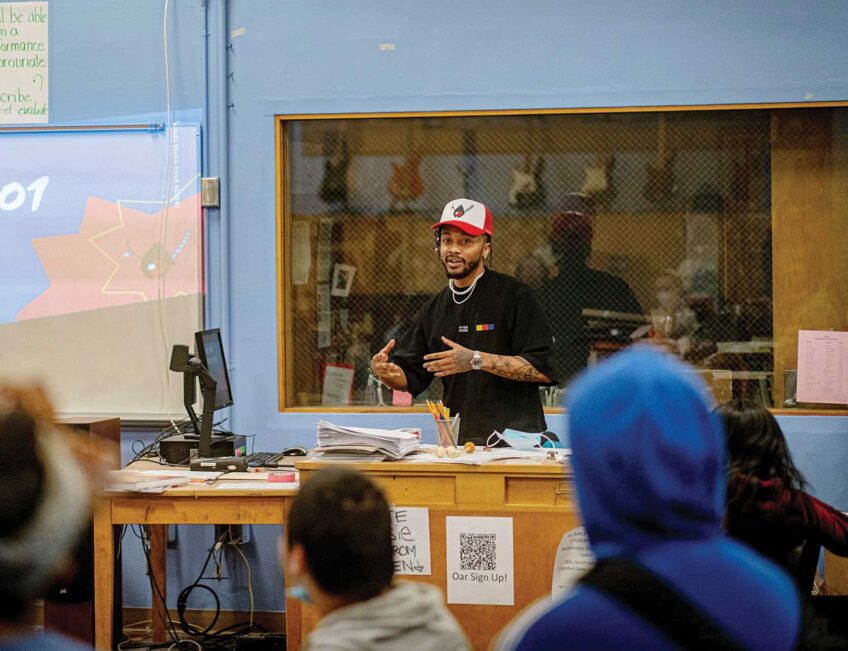Ten years before busing began, Black leaders organized to end school segregation
Organizers of the 1964 Freedom Stay Out and experts who studied it reflect on why the movement was successful — and why it took a decade for change to come

On a wintry morning in 1964, Hubert “Hubie” Jones stood outside bundled in a peacoat, gloves and a fedora, with his toddler son in his arms. Next to him was a school bus with a large banner reading “Newtonites Support Freedom Stayout” in all caps pasted on its side.
The bus was one of a hoard of others that transported white suburban students into Boston where they spent the day learning alongside Black children in 35 Freedom Schools hosted in churches and community centers across Boston.
Long before busing began in the summer of 1974, Black Bostonians had been calling for changes to the education system. They argued that white students received quality education while Black children were saddled with underfunded, dilapidated schools — evidence of “de facto” segregation, or segregation not by law.
So, on that day, February 26, students ditched their regular schools to participate in these temporary, experimental integrated schools during a city-wide Freedom Stay Out led by activists James “Jim” Breeden and Noel Day.
“The Black community was engaged in a fierce battle,” said Jones, 90, who decided to lead a “public purpose life,” when he moved to the Boston area for college. Joining the Stay Out was one way he fulfilled his commitment.
Jones, now a social worker, had been asked to organize the suburban communities in cities like Newton and to drum up support for the movement among white parents and their children. That morning, as he stood outside the bus in Newton, he saw the white students out.
The Stay Out, Jones recalled, was “the Black leadership’s last-ditch effort” to get the Boston School Committee to recognize and act on de facto segregation, which it had continuously denied “because the opposition to the interest” of Black people had “political currency.”
This wasn’t the first time the Stay Out’s organizers had coordinated such a movement. The year before, Breeden and Day, under the organization Citizens for Human Rights, held an ad hoc Stay Out on June 18, 1963, for the same reason. The boycott was much smaller in scale — about 3,000 students stayed home from school or attended Freedom Schools — but it laid the groundwork for the larger 1964 Stay Out.
For Peggy Dammond Preacely, Day’s former wife, who was in her early 20s at the time, the kind of organizing required to execute the 1964 Stay Out was familiar territory. She had been an accomplished public speaker, community organizer, and an early Freedom Rider.
“I think I was probably fired up from having been in the South, having been in jail, having been very angry at America and how we as Black people were being treated,” said Preacely, now 81. “But at the same time, the organizing principles were not difficult for us, and that’s why it was successful.”
The Stay Out organizers — banded under the banner of an organization called the Massachusetts Freedom Movement — leaned into the momentum of 1963, energized by the Stay Out in June and the March on Washington in August.
Thanks to their education as members of the Black middle class, their previous experience with organizations such as the Southern Christian Leadership Conference, and the distribution of the Massachusetts Freedom Movement’s newspaper “Freedom’s Journal,” the leaders reached people of different ethnicities and ages.
To do this, they relied on interracial organizing.
Boston has historically had a smaller Black population than other northern cities, which was especially true during the Great Migration, said Zebulon Vance Miletsky, associate professor of Africana Studies at Stony Brook University and author of “Before Busing: A History of Boston’s Long Black Freedom Struggle.”

Students, parents and teachers on the steps of the St. Marks Freedom School on February 26, 1964. PHOTO: JAMES FRASER PHOTOGRAPH COLLECTION, NORTHEASTERN UNIVERSITY, BOSTON
The Stay Out organizers recognized that Boston had too small a Black population to effect change alone, so they called upon their white allies, some of whom taught in the Freedom Schools.
“Black leaders were not as successful in gaining elected office, but they were successful [in] what we would call community organizing today,” said Miletsky, who grew up in Boston and attended Boston Public Schools in the 1980s and 1990s.
Breeden, Day and their colleagues visited gathering spaces like community centers and churches to get people involved. They also trained students on how to talk to and recruit other students.
Black Bostonians were motivated after months of being told nothing was wrong with their schools.
“And so it all kind of culminated in this expression of, ‘We’re not going to take this anymore,’” said Alyssa Napier, an associate editor at Columbia University Press and former doctoral student in the Harvard University Graduate School of Education.
By the numbers, the organizers’ efforts proved successful. That day 10,000 students attended Freedom Schools across Boston during the Freedom Stay Out, a day that ended in a march to City Hall.
“It was a demonstration that we were tired of raggedy … schools… — overcrowded, old buildings, old books, no pencils,” said Jean McGuire, a longtime activist who supervised some of the Freedom Schools that day.
Like Preacely, McGuire, now in her 90s, was deeply involved in community organizing, having founded the Black Educator’s Alliance of Massachusetts, formerly the Massachusetts Negro Educator’s Association. The Stay Out was just one part of her life of activism.
“It’s just the way Black people live. Everything you do, every job you have, even your marriages are involved with what it means to be ex-slaves,” she said, adding that, “You’re always working towards freedom.”
Despite the sheer scale of the Stay Out, the movement often falls into the shadow of the busing crisis, a better-known chapter of Boston’s desegregation history. One reason for this, Napier said, is the media coverage.
Published 20 years after the 1964 Stay Out and during Boston’s busing crisis, J. Anthony Lukas’ “Common Ground” became the definitive story of desegregation, chronicling the busing crisis through the perspective of three families.
Language may have played a role too.
Where other cities like Chicago and New York called their movements “boycotts,” Boston stuck with the less “scandalous” term of “Stay Out.” News and other media clung to and sensationalized the violent reactions to busing in a way that they couldn’t do with the peaceful Stay Outs, rendering it less talked about.
Long overdue change
Even after the success of the 1964 Stay Out, it was years before Boston’s elected officials responded to the demands of Breeden, Day and their colleagues, because “the Boston School Committee was full of people who did not care about Black people — did not want to change,” Napier said.
Miletsky agreed. Why the Boston School Committee was so resistant to change can be explained by the dynamics of Boston’s population demographics.
At the time, the city was comprised of a unique mix of ethnic and immigrant groups. One of those groups, Irish Americans, held positions on the Boston School Committee, having come into power in the late 19th and 20th centuries.
They had faced discrimination and prejudice in the face of anti-Catholic sentiment in the nation in the late 19th century, Miletsky said, and Boston was also home to the Brahmin, “the proper Bostonian” descended from England, which increased tensions.
“In other words, you have a very strange hierarchy, where, in some ways, African Americans were, at least from the ruling class perspective, seen as being sort of maybe a rung higher in some ways than the Irish themselves,” Miletsky said.
As such, Irish Americans in leadership positions, including those on the School Committee, felt they were defending what was theirs. Because they were unwilling to concede the power they had long been starved of, they refused to acknowledge the requests of Black Bostonians.
When the expected change stalled, Black leaders continued organizing soon after the Stay Out. They founded independent schools, and they created “Operation Exodus,” a busing program within Boston, and the Metropolitan Council for Educational Opportunity, or METCO, which still to this day transports Boston students to suburban schools.
“There’s something really, for me, inspiring about seeing what has been done in the past and seeing how those legacies linger even today,” she said. “People are still making Freedom Schools because that kind of impulse to protect Black children through this very specific expression reverberates throughout history.”
Preacely said she is proud of the work she and other leaders did, adding that the robust curriculum and empowerment contributed positively to the city. But she admitted that much of their work was driven by an almost naive optimism based on the changes happening around the world and in the South back then.
“We felt that all we had to do is call attention to these wrongs…. We knew that the world was not in a wonderful place, but we were still very hopeful,” she said. “And we felt that [the Stay Out] would lead to institutional change.”
Ten years after the Stay Out, on June 21, 1974, Judge W. Arthur Garrity ordered the desegregation of Boston’s schools against the backdrop of mounting racial tensions. Where white people had previously been supportive of integration in the form of the Stay Outs, the reaction to busing was much more violent.
“When talking about busing, or when talking about the history of education in Boston, we’re specifically talking about white Bostonians feeling a type of way, and then white suburbanites feeling differently,” Napier said.
White suburbanites saw the Stay Out as an opportunity for personal enrichment and a way to participate in the Civil Rights Movement, but they were still distant from the nucleus of the issue.
“White suburbanites were all for supporting the problems that were happening in the city because it wasn’t really their problem, yet,” Napier said, adding that “white suburbanites support is not the same thing as white Bostonians.”
When Jones and his fellow organizers began planning the Stay Out, they expected widespread transformation to follow.
“In the 60s … we thought we were going to change the country. We thought we were going to change this region. We thought we were on the way to getting really serious change,” he said. “And … come to find out there were all kinds of ways that made that impossible.”
While the Stay Out didn’t immediately lead to the change in the education system they hoped for, Jones said he recognizes the positives that proceeded — Operation Exodus, METCO, which his wife Catherine Jones was involved in, and the Racial Imbalance Act of 1965, which declared that school systems throughout the Commonwealth had to racially integrate their schools.
Today, the progress is more apparent. Jones pointed to the Boston City Council, which is made up mostly of women and people of color. He didn’t think he’d live to see that happen.
“At the end of the day … it’s a marathon and anybody who wants to get involved in this has to make a commitment for life,” he said. “It’s not: in one day and out the next. It’s staying at this stuff for a long, long time, and that’s what’s going to make change.”






